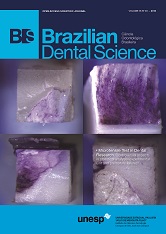Analysis of flexural strength of a self cured acrylic resin used for fabricating provisional restorations with three different types of reinforcements
DOI:
https://doi.org/10.14295/bds.2013.v16i3.905Resumen
Objective: To evaluate the effect of three different types of reinforcements on the flexural strength of a chemically activated acrylic resin.
Materials and Methods: A Universal test machine EMIC 2000 was used at a speed of 5mm/min., to evaluate the flexural strength of 40 test specimens (65mm X 10mm X 3mm) fabricated of chemically activated acrylic resin, distributed into the following four groups: (1) control – without reinforcement; (2) reinforced with 0.7mm stainless steel orthodontic wire; (3) reinforced with Fibrex-lab® glass fiber and; (4) reinforced with Perma-Fiber®glass fiber.
Results: The following flexural strength values were obtained: Group 1 – 80.60 MPa; Group 2 – 95.96 MPa; Group 3 – 105.70 MPa; and Group 4 – 108.70 MPa. The analysis of variance (p < 0.05) showed significant difference among the groups and the Tukey test showed that the control group presented the worst behavior, followed by reinforcement with metal wire, which showed statistically similar results to those of Group 3, with no difference shown between the fiber groups.
Conclusion: Reinforcement with glass fibers present better flexural strength in comparison with the other methods.
Descargas
Descargas
Publicado
Cómo citar
Número
Sección
Licencia
Brazilian Dental Science uses the Creative Commons (CC-BY 4.0) license, thus preserving the integrity of articles in an open access environment. The journal allows the author to retain publishing rights without restrictions.
=================
COPYRIGHT TRANSFER AND RESPONSIBILITY STATEMENT
(PDF)
For all articles published in the BDS journal, copyright is retained by the authors. Articles are licensed under an open-access Creative Commons CC BY 4.0 license, meaning that anyone may download and read the paper for free. In addition, the article may be reused and quoted, provided that the original published version is cited. These conditions allow for maximum use and exposure of the work while ensuring that the authors receive proper credit. All metadata associated with published articles is released under the Creative Commons CC0 Universal Public Domain Dedication.
Before the submission, authors must obtain permission to reproduce any published material (figures, schemes, tables, or any extract of a text) that does not fall into the public domain or for which they do not hold the copyright. Permission should be requested by the authors from the copyright holder (usually the Publisher, please refer to the imprint of the individual publications to identify the copyright holder).
The authors hereby attest that the study is original and does not present manipulated data, fraud, or plagiarism. All names listed made a significant scientific contribution to the study, are aware of the presented data, and agree with the final version of the manuscript. They assume complete responsibility for the ethical aspects of the study.
This text must be printed and signed by all authors. The scanned version should be submitted as supplemental file during the submission process.
























